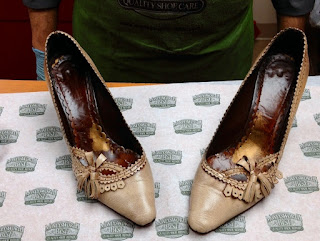In this post, I wrote about a very beloved pair of shoes. These were my first love in shoes so naturally over the years I’ve done all I could to take care of them.

But now it had finally come to the time where they needed something a bit more drastic. What I wanted was for the very pointed part of the toe to be trimmed down to a regular almond toe. So, off I went to my trusted shoe guy.
Before he could even give me an answer as to whether or not he would be able to do what I wanted, he had to painstakingly peel back the top layer of the leather from the underlying structural material. This had to be done in order for him to see what condition the bottom part of the shoe would be in and whether there would be enough leather left for him to work with. After several days of him working on it in his spare time - I soon learned that this was bit of a labour of love for him - heating the shoe to soften the leather and glue, peeling it back literally millimetre by millimetre, he finally told me that yes, he would try. But, he could not guarantee the end result. Did I still want to continue? I did... I had no doubt that he wouldn’t even start if he couldn’t do it.
At this point he had to create a new model for what the shoe would look like; after several foot measurements, he was ready to create a mold and... to start cutting! After one last “Are you sure?” the tip of the shoe came off. And the trimming, and the measuring began.
Finally, after over a month of working on them, he called me... for help. At the bottom of the shoe, where the leather meets the sole, the original leather wasn’t strong enough so he had to augment it with new leather but, the new leather didn’t quite match the old. And after trying out several combinations of their leather dye, he had been unable to match the finish on the shoe.
Considering the vast array of nail polish colours, they had the brilliant idea to use nail polish to touch up a few parts where the finish was uneven! So, off I went to several stores until I finally found a colour that he liked. The polish got mixed in with his secret shoe making ingredients, they were put in an oven, they were buffed and sprayed and steamed and I don’t know what all but finally, a few days later, he called me again - this time to come have a look. And just look at the magic he performed!

